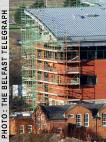Irish republicans used cameras to spy on MI5
September 13, 2010 1 Comment

Palace Barracks
By JOSEPH FITSANAKIS | intelNews.org |
British government officials in Northern Ireland have ordered 20 trees cut down outside a spying installation, after a number of surveillance cameras were discovered hidden among the tree branches. The trees are located around a multimillion-dollar spying base belonging to MI5, Britain’s primary domestic intelligence organization. The base, which serves as MI5’s headquarters in Northern Ireland, is located in Holywood, County Down, inside a British Army installation named Palace Barracks. Eyebrows were raised on April 12, when a dissident republican group managed to detonate a massive car bomb inside the maximum-security base. The bomb was carried into the base by a local taxi driver, who had been forced by paramilitaries at gunpoint to smuggle it into the facility. British media initially attributed the attack to the Real Irish Republican Army (RIRA), but it was later blamed on Óglaigh na hÉireann (ONH), which split from the Continuity Irish Republican Army (CIRA) four years ago. According to the Belfast Telegraph, which broke the hidden cameras story, the surveillance equipment is believed to have been clandestinely placed around the MI5 base by ONH members, during the planning stage of last April’s bomb. The paper says MI5 believe that the ONH used captured images to identify military and civilian employees at Palace Barracks, and even to “build profiles on some of MI5’s 300 staff at the complex”.







Interesting. The DG of the security services recently rated the dissident republican threat as rapidly escalating. It makes one wonder why they would treat potential infiltrators as shabbily as ‘Amir’ appears to have been treated.